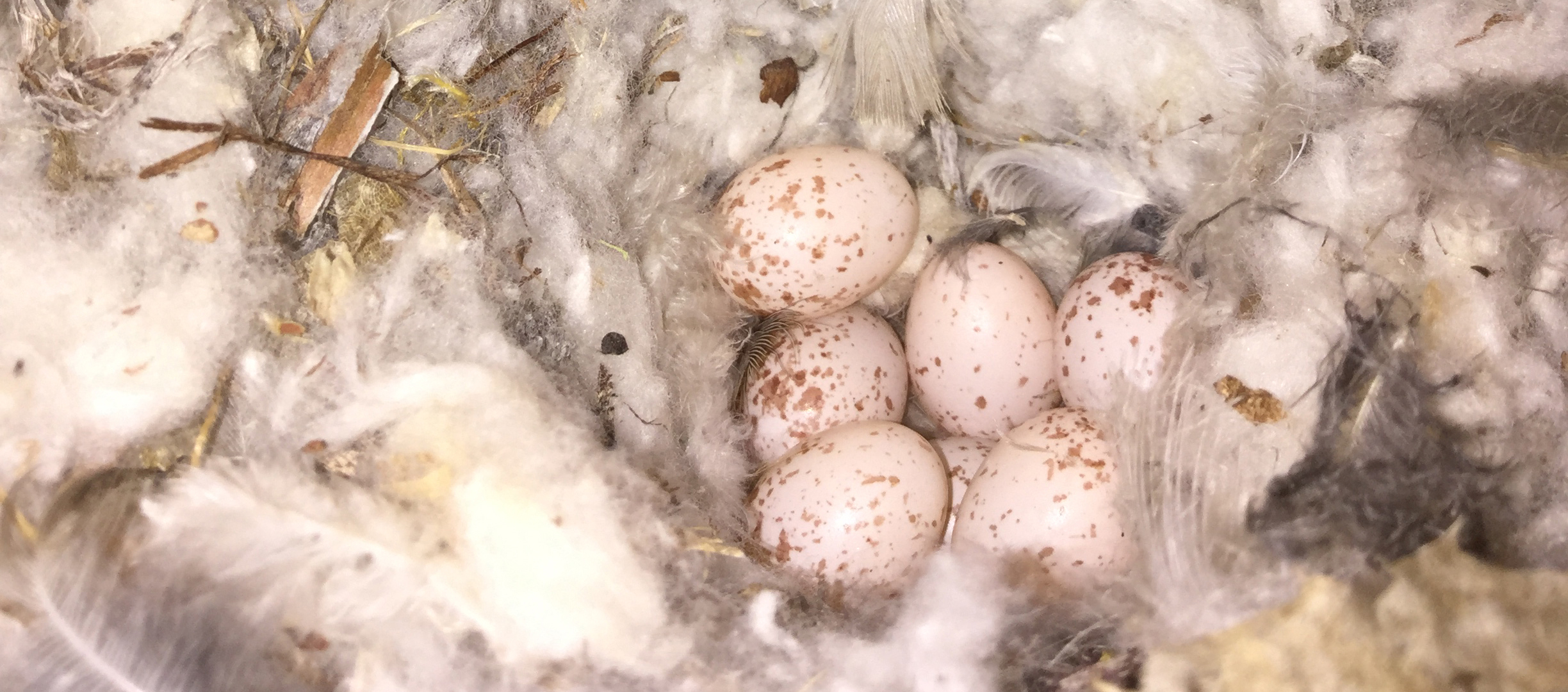 Photo ©
Janice Farney
Photo ©
Janice Farney
By Gina Gerken, NestWatcher and community leader
In 2003, my husband, kids, and I moved to a ponderosa pine forest community in Castle Rock, Colorado. I had always enjoyed birds and bird watching, but at this time of my life birding was only an occasional hobby for me. We arrived in Castle Rock only to discover our new stucco home being wildly attacked by a merry band of Pygmy Nuthatches. The tiny “nuthatchers,” as the neighbors called them, were drilling holes on two sides of the house and loudly socializing as they drilled. I was both mesmerized and horrified, watching a snowfall of styrofoam falling from stubby beaks poking out little holes. I soon discovered that many others in my community were plagued with the same problem, and due to worries of mold and expensive stucco repairs, neighbors were on the warpath. Contractors were apparently continually filling holes only to have the determined birds immediately begin to re-drill. I feared the holes would be filled during the nesting season with young birds inside. Thus, I became obsessed with learning how to solve this problem and to figure out a way to coexist with these incredible little stinkers.
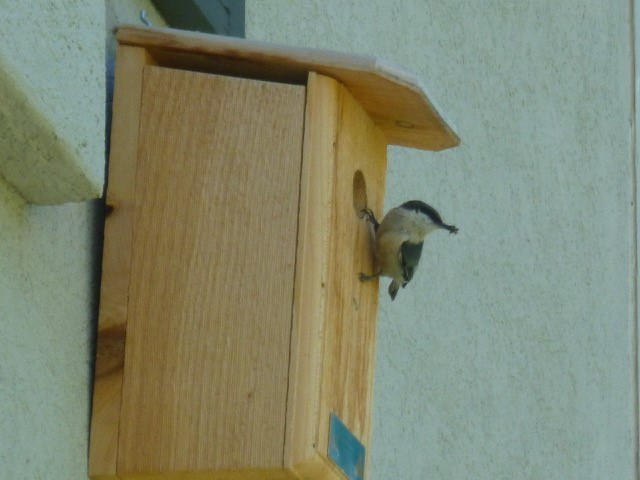
Stuck on Stucco
When Pygmy Nuthatches were drilling holes in stucco homes, residents felt powerless to stop them. That is, until we discovered what they were really after—nesting and roosting holes!
Unfortunately in 2003, little was being discussed on the internet regarding Pygmy Nuthatches, and I was having no luck at first finding good information. I finally contacted Denver Audubon and was introduced to the wonders of The Cornell Lab. Thanks to learning everything I could about this complex little bird, especially why they were so highly driven to have cavities year-round for both roosting and nesting, I developed a plan of action. I figured out a way to put appropriately-sized nest boxes in ideal spots. I hung boxes high, where I could easily access them by opening windows. Oftentimes I was able to hang them directly over an actual hole that was in process, knowing it was a time of year when the birds were neither nesting nor having to deal with cool temperatures. I was incredibly lucky, too. Literally within an hour of completing my project, nuthatches were going in, out, and all over the boxes. Over the next few days, they continued to explore their new potential homes and the drilling slowed greatly. It wasn’t long before I noticed two of the boxes in particular were already being used for nighttime roosting.
A few weeks after initially hanging boxes, we filled the holes that the nuthatches had drilled. I expected to have at least some initial re-drilling, but was totally surprised to have absolutely none. The birds seemed to have completely transitioned. We never again saw a hole, and the boxes were used for years. My kids especially loved watching out windows at dusk to see little Pygmy Nuthatches disappearing inside one-by-one to sleep! Without all the in-depth information I had gathered from Cornell, I’m not sure I would have had the success that I did working through this issue.
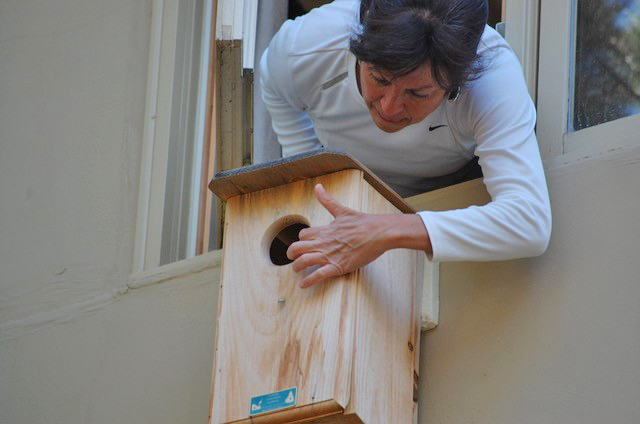
Working With, Not Against, Wildlife
In order to welcome even more birds, this small owl box was hung on the outside of my former home.
Because of my nest box success, I felt compelled to share what I had learned. I wanted to help others, both humans and birds, so I approached our local newsletter editor and offered to write an article. Thus began my first community involvement with bird education. Soon, I was making house calls to give suggestions to those having nuthatch issues. I also began adding more nesting boxes to the sides of my house for other birds. At one point, I had every cavity-nesting bird species known to our area (sometimes multiple pairs on opposite sides) either in a box on my house or in my yard, including Northern Saw-whet Owls! I had fun bringing groups of people to my property in late spring to see all the nesting birds. I was also asked to write more articles on birds for our newsletter, which I continued to do for 15 years.
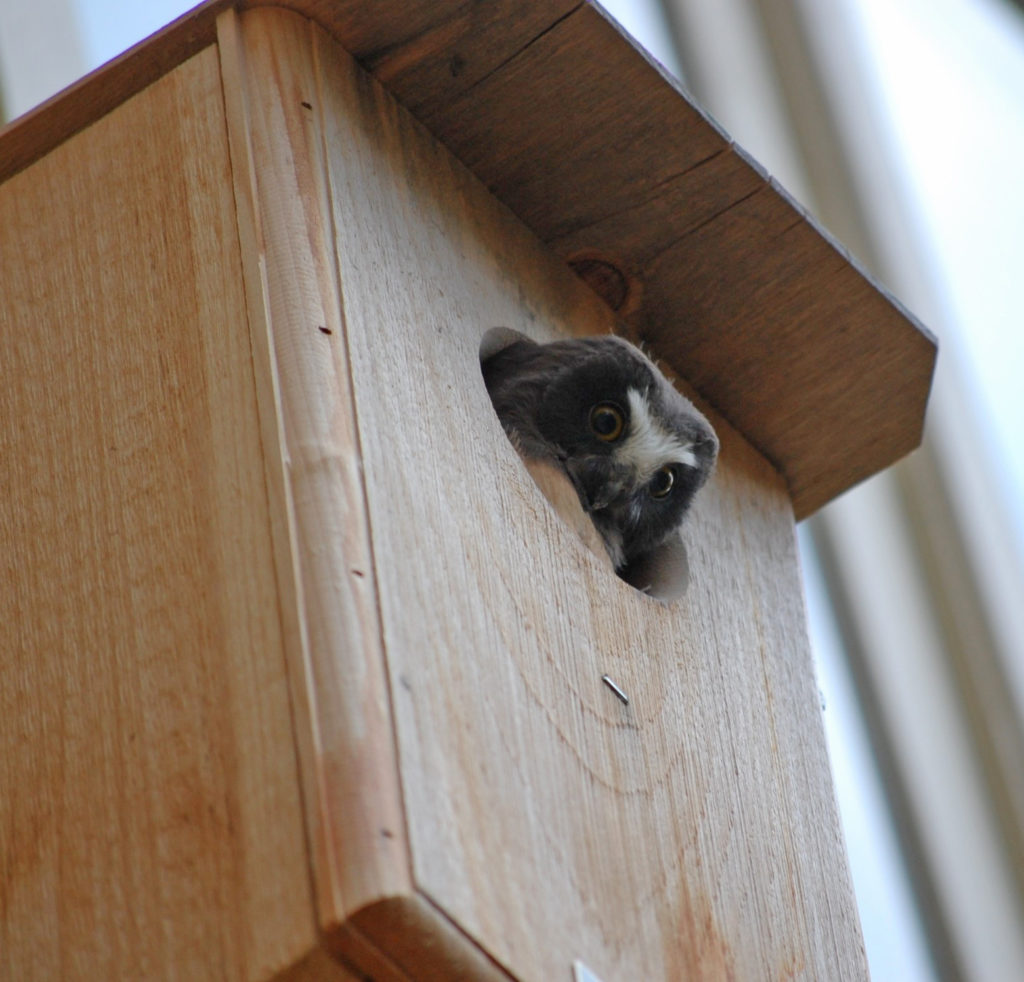
Owl Be Right Here
A nestling Northern Saw-whet Owl peeks out from a nest box mounted on an exterior wall.
From there my involvement blossomed into a role on the Wildlife Committee of our HOA, which was formed to educate residents on how to coexist. I eventually became the committee chair and served for many years. I used committee funding to organize events to help educate our residents on the importance of each species and how we needed to behave to best preserve them. I brought in speakers, organized events (especially for kids), and led nature walks.
In 2006, I used Wildlife Committee funds to install a 75-box bluebird nest box trail throughout the community. Yet again, I used Cornell resources to educate myself on cavity-nesting birds that might use the trail. For 12 years, I managed the trail and did data entry through NestWatch. It was extremely satisfying knowing that over 3,000 secondary cavity-nesting birds had fledged from our boxes and at the same time we had educated many resident volunteers as well.
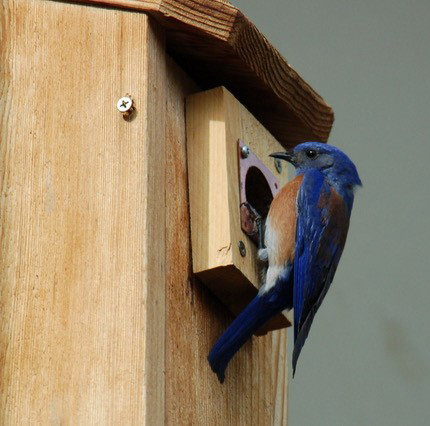
Welcome to the Neighborhood
Our neighborhood installed a 75-box nest box trail in the community and recruited volunteers to help collect data. This Western Bluebird male is checking out the new accommodations.
This past year, my husband and I decided we were ready for a new adventure and moved from Colorado to Southern California. While I will miss all that I came to love in the natural world of Castle Rock, it is exciting for me to discover a new ecosystem and to be introduced to new “life birds.” Thank you so much to the Cornell Lab of Ornithology for giving me the resources to help myself and others learn about our amazing birds! Changing the behavior of one person to save the life of one bird—it makes it all worthwhile.
Wow. Excellent information. Thank you!
You are so welcome! I first lost my ❤️ to Pygmy Nuthatches and then of course to every other wild bird that came into my life. Ask me my favorite bird and it depends on the day of the week!
Fabulous story of success! Thank you! On a similar note, my condo complex in Carpinteria, CA. is the favored nesting location of cliff swallows. Folks are besides themselves trying to discourage this behavior. Do you know, other than netting the areas where the walls meet the roof, how we can discourage them from nesting? I personally don’t mind the mess of the mud and the poop because once I saw the little faces of the baby swallows poke out of the mud house, I was transfixed and totally smitten. Others, however, just see the mess! Thanks!.
Hi Jane, We’ve had some people with similar problems mention that they set up flowerbeds beneath the swallow nests to help reduce the mess on the ground (it also provides a kind of fertilizer for the plants!), but otherwise, the best way to discourage swallows from nesting along houses is unfortunately to block off the area where they attempt to nest. These birds naturally nest on cliffs, caves, rock ledges, etc. and if this kind of habitat is scarce, then buildings, bridges, culverts, and houses are the next best thing in their eyes.
Thanks!
Currently we have a pair E. Blue Birds nesting in a box with baby birds. About 25 ft away Robins nested but nestlings gone – nest empty. This is 3rd yr Robins have harassed the BB – sitting on box top or other agresive behaviors. Are robins anti BBs??
Burlington NC
birds – both leave the nest box. Robins have made nests and sent fledglings into the world.
Hi Judith, some birds are fairly territorial during the breeding season and defend their nests accordingly. In this case the robins have no reason to worry about bluebirds, but hormones during the breeding season can be quite a strong, and overzealous, influence on behavior.
This is so inspiring. A good reminder to hang my western bluebird nest box this weekend.Thank you for your hard and persistent work and good luck to you in your new home.
Thank you Janet!
I have pygmy nuthatches here in our area of Flagstaff, AZ. I will take up this idea and try it out! Thanks! MP
Thank you Martha! Good luck with your Pygmies! While they will use a box that is to the specs of a bluebird box, with a 1.5″ diameter hole, I had more success with “chickadee/nuthatch” boxes that are smaller, and with a smaller hole (but not quite as small as some of the boxes out there that are sold as wren boxes.) They will nest in boxes in the spring, but they will also use boxes year round to roost in as well. But even for roosting, they seem to prefer a regular nest box and will cuddle up in layered groups at the bottom and up against the sides of the box. I tried using a roost box that had small removable dowel perches inside and they actually removed them! They are such fascinating birds!!!
I love this story! You did a great things for the birds, but also for the people in your community! I love knowing the Cornell Lab for Ornithology gave you the resources to do that, because I support them!
Thank you Carol!
We did the same thing when Northern Flickers started ventilating the side of our house and the neighbors houses in Colorado Springs. My husband patched the hole with a metal plate and then he put up a nest box for them over the patch. We never had another hole drilled into our house and it was great fun to watch the Flickers build their nests and raise their young. One thing we did find out is that these birds need to have the feeling that they are pecking out a new hole each time so we would stuff the house with pine shavings so the birds would have something to clear out. It worked like a charm. We had some very happy birds. Other birds then would pick up the pine shavings and add them to their nests so it was a win-win all around.
Very interesting and educational! We live in St. Paul, Minnesota and have had downy woodpeckers drilling into the north side of our house, which is enclosed in cedar siding. No woodpecker deterrents (such as the colorful inflatable plastic balls) work to deter them. We currently have about 24 holes that we’re temporarily filling and will permanently fill when the weather gets warmer. Any experience from someone out there as to whether the nest boxes or something else may work to prevent the downy drilling?
Hi Michele, Downies have not been known to be reliably attracted to nest boxes, but I think it’s certainly worth a try to put one up. I also recommend checking out this article about other reasons why the woodpeckers might be creating holes in your siding.
Hi Michele – Downy Woodpeckers were the only cavity nesting birds in my area that never used one of my nest boxes, however they did have several holes nearby, in thin pine tree trunks. I often wondered if it was because they didn’t like square wooden boxes and might prefer a cylinder? I made a 4″diameter PVC pipe nest box to try, but it was first used by a White-breasted Nuthatch before House Wrens took it over for good:). You might want to try a cylinder box (there are plans online, as well as ready made boxes you can buy), and if you’re building it yourself, I might try a 5″ diameter cylinder? The holes I found that they had drilled were either at my eye level or just a few feet above and faced either S, E, or SE, do I might hang the box at that level and in that direction. I would put in some pine shavings (you can buy pet bedding at a pet store), packing them in and fill it to about 5″ below the hole. They will remove some of the shaving themselves to get the depth they would like. I read somewhere that having them be forced to do a bit of removal themselves make them more likely to use the box? Who knows:) I also might tilt the cylinder a bit forward, especially if it’s slick inside, to help the babies be able to climb out more easily and maybe even make some cuts inside, below the door, to roughen up the plastic if there are not already groves there in a purchased box. Hope this might help!
What a fabulous success story for the people and the birds!!
Thank you and Cornell. What a lovely, inspiring story. Now,, I have to get some nest boxes. Did you make your boxes? Thank you so much for helping the birds and for lifting my spirits.
Thank you Sharon – you lifted my spirits as well! While I did once make a nest box out of PVC pipe when I read that chickadees might prefer them, almost all of my boxes were wooden. Our local Audubon society sells boxes that are made by volunteers. You can also find plans to use to make them on NestWatch, and also boxes are sold in stores and online.
Good for you! That’s a great example of how one person can make a difference, simply by putting up a nest box and seeing that it works!
It brings tears to my eyes to see that a real human being actually took the time and cared enough to do something right. Life is so precious and being able to accommodate creatures of a different species and seeing a positive outcome is to be embraced. Too many are totally blind of the outside world and take wild life for granted or don’t care because it doesn’t matter or affect them. Wildlife is a gift of God. We can learn so much from them if we just open our minds and care
I have a lot of both White Breasted and Red Breasted and have vever had a drilling issue. We do have a lot of woods around us and Bluebird houses. Had more trouble with Wrens. Found out from Wild Birds that they were the ones killing my baby Bluebirds. I rearranged the nest boxes last Fall so will see come Spring/Summer
Your success story brought me to happy tears! Thank you from the bottom of my heart! I live along a creekside trail and am considering doing similar in my toen. Once again, Thank You for your fantastic story!
Thank you Hazel!
I will try the same solution to my downy wood peckers, they regularly drill holes in my cedar siding. I thought they were after grubs but perhaps it is nest holes.
You remind us all that experiments cost little and can bring great rewards
Congratulations 🎉!
Your personal experiences and story testimony was very interesting.
I enjoyed it. Thank you for sharing.
Thank you Francis!!
Gina, you are living my dream! Such a joyful, informative read! Bravo on the ingenuity and rallying community involvement!
What a great little story! I gathered materials to build a few boxes for my trees along the creek; a tributary of the Chesapeake Bay in Virginia. Your story is motivating me to get going. I’ll invite my neighbors and the children for a nest building party. Thanks so much!
I’m so glad and you’ve got a great idea! We actually got nest box kits from our local Audubon Society and let kids and families help put them together. It gave the kids a feeling of ownership in the boxes and the project and they loved it!
Enjoyed the blog and am inspired to add nesting boxes on our property!!!
Thank you Marcia!
Very interesting and informative read! I enjoyed your article and pictures, and commend you for not only assisting the birds causing you trouble, but also sharing your experience so others can understand that coexisting with our nature neighbors is far better than fighting a losing battle with them.
I can relate to your experience. I had flickers creating a construction site on my house in Colorado. Many holes were drilled and quite a noisy worksite to boot!
I hung a box made especially for these cute woodpeckers and it was quickly rented by a flicker couple who not only provided entertainment for me, but defended their territory from all the other hole digging prospective parents who were costing me a ton of stucco wall repairs.
I look forward to reading more of your articles. You inspire folks to reach beyond what looks like a ‘pest’ problem by contacting great sources like Cornell, and turning it into a active learning experience that benefits both the birds and the birdwatchers!
Great articles and comments! Anyone have a suggestion on how to keep a woodpecker from drilling the metal flu on top of our chimney?
Hi Nancy, Woodpeckers drilling on metal like that are usually doing so to announce their territories or to otherwise gain attention (rather than doing so for nesting space or for food). There’s probably not much you can do to prevent it, other than putting up some kind of netting or chicken wire around the flu so that the bird can’t access it. Read more about how to deal with woodpeckers on your house here.
Loved your article. I have a white-chested nuthatch nesting in a box on my house now. This is their second year! Since last year I have added two wren boxes and a screech owl box. I’ve seen chickadees, titmice, and finches checking them out, but nothing yet. No one at the owl box but fingers crossed 🙂
Hooray for co-existing success stories like this! Thanks for finding a creative solution, Gina!
How can I get more information about the size of the boxes, and where to put them? They are destroying my stucco house!
Hi Layne, we have a multitude of construction plans for nest structures in our Right Bird, Right House tool. The Pygmy Nuthatch plan is here.
Thank you for your help. I hope it’s okay if I ask you another question. We have Pygmy nuthatch families that have made holes in the stucco and live in the walls way up high in the peaks of our house. They have pecked holes all over the house, as well. We need a solution to this damaging issue. We have heard that people patch the holes and put the bird house over the hole and the birds move in. Simple! However, at this point they have babies in the peaks. How/when should I try to transition them to the nesting boxes? We have tried plastic owls, shiny streamers, screeching bird noises, etc, but they are there to stay. Please help!!!
So helpful. Thanks for these great tips. I will repair and rebuild the nest boxes in my garden; and I will hang them up high so I can avoid insects and squirrels when I feed the birds.